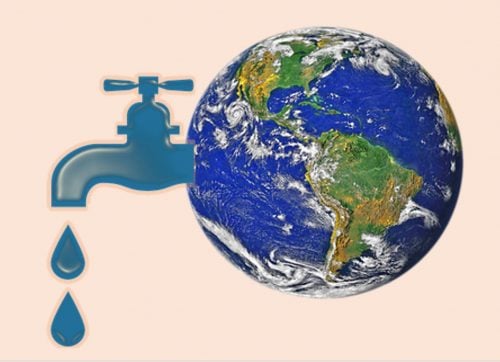We need to increase our use of nature-based solutions – where we work more with nature – says a new report on global water management by the United Nations.
“We need new solutions in managing water resources,” says Audrey Azoulay, Director-General of UNESCO, “so as to meet emerging challenges to water security caused by population growth and climate change.”
 Greater use of nature-based solutions will help us toward a more holistic approach to managing global water resources. Image: CP/pixabay composite.
Greater use of nature-based solutions will help us toward a more holistic approach to managing global water resources. Image: CP/pixabay composite.
The 2018 United Nations World Water Development Report featured recently at the 8th World Water Forum in Brasilia, Brazil.
Holistic approach to water management
The report argues that nature-based solutions are one of the many essential tools for moving toward “a more holistic approach to water management.”
Nature-based solutions support the idea that water is not an isolated element but an inseparable part of a cycle of evaporation, precipitation, and absorption through the soil.
Grasslands, forests, and wetlands – and the extensive vegetation cover that they provide – have a profound effect on the water cycle and by focusing on them we can do much to improve the amount and quality of water that is available.
The report says that we need to make more use of environmental engineering that focuses on “green infrastructure” rather than just “grey infrastructure” solutions provided by traditional civil engineering.
This does not mean that we do not continue to seek civil engineering solutions in the form of irrigation canals, reservoirs, and water treatment plants, but look to increase nature-based solutions to complement them.
Benefits of ‘green infrastructure’
Green infrastructure has much to offer water-intensive applications such as agriculture. For example, it can help to reduce soil erosion, pollution, and the amount of water required by making irrigation systems more efficient.
An example of this is the change that has occurred in recent decades in the Indian state of Rajasthan, which suffered one of its worst droughts ever in 1986.
In the years that followed, collaboration between an NGO and local communities established ways of harvesting water that regenerated forests and soils.
As a result, forest cover in the state increased by 30 percent, groundwater levels went up several meters, and productivity of croplands improved.
“For too long,” says Azoulay, “the world has turned first to human-built, or ‘grey’, infrastructure to improve water management. In so doing, it has often brushed aside traditional and Indigenous knowledge that embraces greener approaches.”
System of Rice Intensification
Another example in which turning to a greener approach leads to more effective use of water resources is the System of Rice Intensification (SRI) that was introduced originally in Madagascar.
SRI is described as a “flexible set of farming practices” that results in higher crop yields while simultaneously “reducing input requirements, especially seeds, agro-chemicals and water.”
SRI focuses on the function of soils in terms of water content and ecology – rather than turning to new varieties of crops or chemical agents.
Depending on the region in which it is introduced, SRI can reduce water usage by 25-50 percent, it can reduce seed usage by 80-90 percent, while raising crop yields by 25-50 percent.
Increasing crop yields
The new report suggests that adopting greener water management using such nature-based solutions could raise global agricultural output by 20 percent.
It cites a study that reviewed projects in 57 low-income countries in which crop yields rose by 79 percent on average as a result of combining more effective water management with improving soil cover and less pesticide use.
Such gains can also be made in urban areas, argues the report. Bringing together a whole host of measures – such as recycling water, recharging groundwater with water retention hollows, and protecting watersheds – adds up to a significant saving.
An example of this is New York City, where, since 1990, there has been a concentrated effort to protect the city’s three largest watersheds. This has resulted in US$ 300 million of annual savings on the costs of water treatment and maintenance.
Value of wetlands
Another example is China’s recently launched initiative to increase water availability in 16 cities. Called “Sponge City,” the project aims to recycle 70 percent of rainwater by restoring adjacent wetlands and increasing soil permeation, retention, and storage.
Although wetlands cover less than 3 percent of the planet, they have a big influence on water resources; for instance they filter toxins that get into the water system from pesticides, industry, and mining. Studies suggest that wetlands remove 20-60 percent of metals contained in water and can trap up to 90 percent of sediment in run-off.
More and more countries are waking up to the value of making more use of wetlands, and the report cites many examples. In Ukraine, for instance, projects are being set up to get wetlands to remove pharmaceutical substances from wastewater.
Other examples of making better use of wetlands includes using them to protect coastal regions from natural disasters.
For example, after the 2010 tsunami, Chile implemented a number of wetland measures, as did the State of Louisiana in the United States, following Hurricane Katrina in 2005, which would not have caused so much devastation had the Mississippi Delta wetlands not been so degraded.
Despite the many new initiatives, the report maintains that the “use of nature-based solutions remains marginal.” Too much investment is being ploughed into grey infrastructure, it argues.
There needs to be a better balance between nature-based solutions and the human-built ones, say the authors, if we are to satisfy the ever-rising demand for water.
“If we do nothing,” Azoulay urges, “some five billion people will be living in areas with poor access to water by 2050.”
